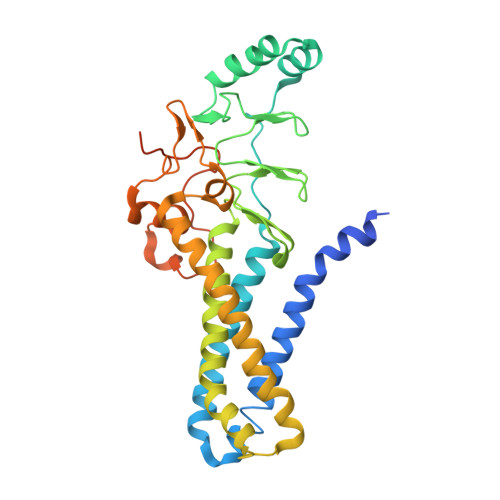Bivalent recognition of fatty acyl-CoA by a human integral membrane palmitoyltransferase.
Lee, C.J., Stix, R., Rana, M.S., Shikwana, F., Murphy, R.E., Ghirlando, R., Faraldo-Gomez, J.D., Banerjee, A.(2022) Proc Natl Acad Sci U S A 119
- PubMed: 35140179
- DOI: https://doi.org/10.1073/pnas.2022050119
- Primary Citation of Related Structures:
7KHM - PubMed Abstract:
S-acylation, also known as palmitoylation, is the most abundant form of protein lipidation in humans. This reversible posttranslational modification, which targets thousands of proteins, is catalyzed by 23 members of the DHHC family of integral membrane enzymes. DHHC enzymes use fatty acyl-CoA as the ubiquitous fatty acyl donor and become autoacylated at a catalytic cysteine; this intermediate subsequently transfers the fatty acyl group to a cysteine in the target protein. Protein S-acylation intersects with almost all areas of human physiology, and several DHHC enzymes are considered as possible therapeutic targets against diseases such as cancer. These efforts would greatly benefit from a detailed understanding of the molecular basis for this crucial enzymatic reaction. Here, we combine X-ray crystallography with all-atom molecular dynamics simulations to elucidate the structure of the precatalytic complex of human DHHC20 in complex with palmitoyl CoA. The resulting structure reveals that the fatty acyl chain inserts into a hydrophobic pocket within the transmembrane spanning region of the protein, whereas the CoA headgroup is recognized by the cytosolic domain through polar and ionic interactions. Biochemical experiments corroborate the predictions from our structural model. We show, using both computational and experimental analyses, that palmitoyl CoA acts as a bivalent ligand where the interaction of the DHHC enzyme with both the fatty acyl chain and the CoA headgroup is important for catalytic chemistry to proceed. This bivalency explains how, in the presence of high concentrations of free CoA under physiological conditions, DHHC enzymes can efficiently use palmitoyl CoA as a substrate for autoacylation.
- Section on Structural and Chemical Biology of Membrane Proteins, Eunice Kennedy Shriver National Institute of Child Health and Human Development, NIH, Bethesda, MD 20892.
Organizational Affiliation:



















